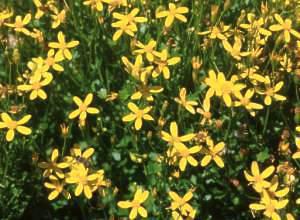Cineraria saxifraga
Cineraria saxifraga DC.
Family: Asteraceae
Common names: wild cineraria; geelblom
Introduction
Cineraria saxifraga, with its delicate foliage and bright yellow flowers, is a rewarding and versatile plant for the garden.

Description
Description
It is a soft perennial shrublet with a spreading, rounded, bushy habit reaching a height of 20 - 30 cm and a spread of about 40 cm. It has attractive light green, hairless leaves. Each leaf is quite small (1-2 cm x 1-1.5 cm) broadly triangular to almost semi-circular, palmately-veined and lobed (i.e. the veins originate at the same point at the base of the leaf).

During spring and autumn the little bushes are speckled with masses of small, bright yellow daisies. Flowers are also produced here and there during summer, peaking during spring and autumn. The seeds, dispersed by wind, are black,very small and light flat oblongs, with a tuft of fluffy, whitish hairs at one end (the pappus).
Distribution and habitat
Distribution description
Cineraria is a genus of herbs and subshrubs of approximately 50 species and occurs throughout Africa. Only two species are known to occur outside Africa, one with a distribution that extends into Yemen and one that occurs in Madagascar. The centre of diversification is southern Africa, where at least forty (80%) of the currently described species ocurr.
Cineraria saxifraga occurs naturally from Swellendam in the Western Cape to the Eastern Cape, where it usually grows on rocky slopes in the shade.
Derivation of name and historical aspects
History
The genus name Cineraria means grey or ash-coloured from the Latin cinerarius and refers to the leaf colour of the first known species. Cineraria belongs in the Asteraceae (daisy family), a huge family, placed in the tribe Senecioneae, of some 1535 genera and 25 000 species spread all over the world and absent only from Antarctica.
The species name saxifraga means of the rocks in Latin and alludes to this species preference for a rocky habitat.
Although the common name of Cineraria saxifraga is the wild cineraria, this species does not look much like the brightly and variously coloured annuals or biennials that are also called cineraria or florist's cineraria. These cinerarias are in fact hybrids based on Pericallis cruenta and Pericallis lanata, both natives of the Canary Islands, and both having undergone name changes from Cineraria to Senecio to Pericallis, as the botanists try to bring taxonomic order to the huge and diverse daisy family.
Growing Cineraria saxifraga
Grow
With its neat rounded shape, Cineraria saxifraga makes an excellent edging plant. It is also an attractive addition to the mixed border and the rockery, a good ground-cover in semi-shade and it will drape over terraced walls. It also makes an excellent container plant suitable for window boxes and hanging baskets. Plants do not require pruning, but can be cut back where necessary. They will last for a number of years, but may become a bit woody and scruffy with age. At Kirstenbosch, to keep them looking at their best, we replace them with young plants every four to five years.
Cineraria saxifraga is fast-growing and very easy to grow. It does best in well-drained, well-composted soil in semi-shade to full sun. A plant in a sunny situation will be more compact than one in a shadier spot. It needs regular watering until established, after which it will survive quite happily on much less. It is suitable for inland and coastal gardens and can withstand light frost (zone 10: -1 to 4°C / 20 to 30°F) although it is better suited to frost-free gardens (zone 11: above 4°C / 40°F).
Cineraria saxifraga is propagated by means of cuttings or seed, or rooted runners can be removed from an established plant. A new plant produced from a cutting or a runner will take about three months to reach a good size.
Cuttings can be taken during spring, summer or autumn. It is very easy to root, and although best results are obtained using the nursery facilities, i.e. dipping the cut ends into a suitable rooting hormone powder and planting them in a well aerated medium e.g. equal parts of milled bark and polystyrene and then placing them over bottom heat of ±23°C under intermittent mist, rooting will also occur if the cuttings are placed in a cool spot and kept moist. Seed can be sown in autumn in frost free climates, or in spring and early summer.
References
- Cron, G.V. & Balkwil, K., 1997, Cineraria cyanomontana and C. argillacea, two new montane endemics from South Africa, South African Journal of Botany, Volume 63 (6): 400-402
- Goldblatt, P. & Manning, J., 2000, Cape Plants, A Conspectus of the Cape Flora of South Africa, NBI, Pretoria & Missouri Botanical Garden Press, Missouri
- Leistner, O.A. (ed.), 2000, Seed plants of southern Africa: families and genera, Strelitzia 10., National Botanical Institute, Pretoria
- Jackson, W.P.U., 1990, Origins and Meanings of Names of South African Plant Genera, U.C.T. Printing Dept., Cape Town.
Credits
Authors: Ebrahim Lawrence & Alice Notten
Kirstenbosch National Botanical Garden
March 2002
Plant Attributes:
Plant Type: Ground Cover, Perennial, Scrambler, Shrub
SA Distribution: Eastern Cape, Western Cape
Soil type: Sandy, Loam
Flowering season: Spring, Early Summer
PH: Acid, Neutral
Flower colour: Yellow
Aspect: Full Sun, Morning Sun (Semi Shade), Afternoon Sun (Semi Shade)
Gardening skill: Easy
Special Features:
Horticultural zones











Rate this article
Article well written and informative
Rate this plant
Is this an interesting plant?
Login to add your Comment
Back to topNot registered yet? Click here to register.